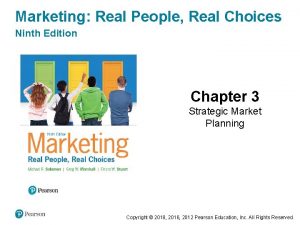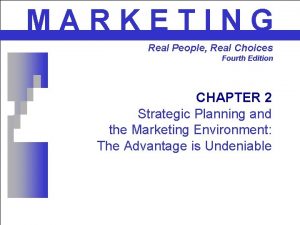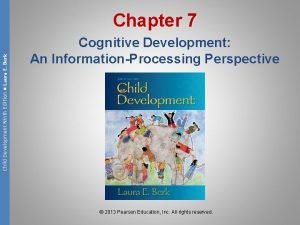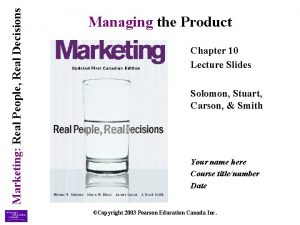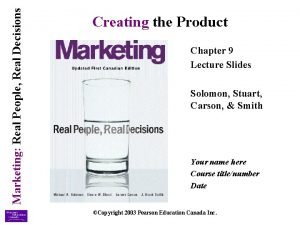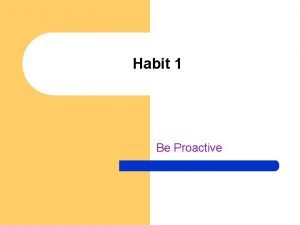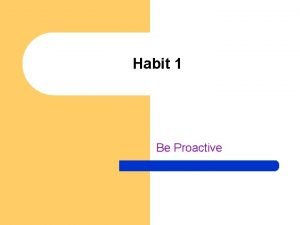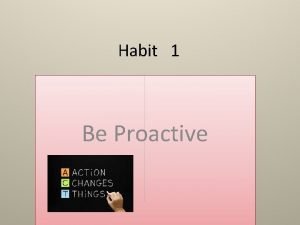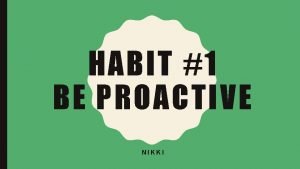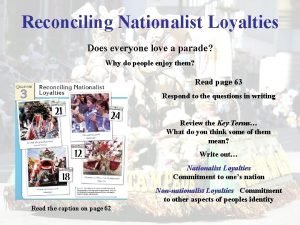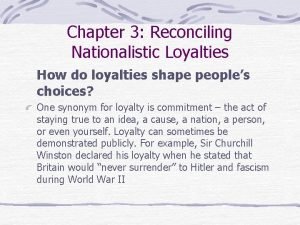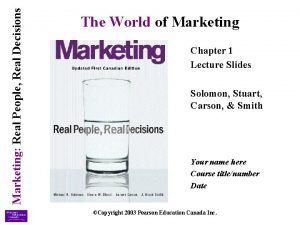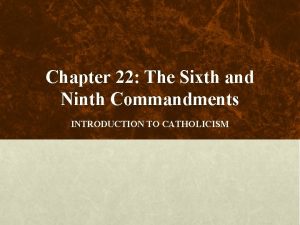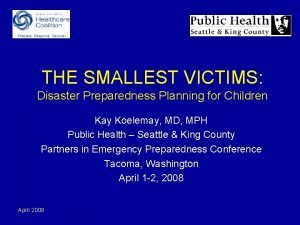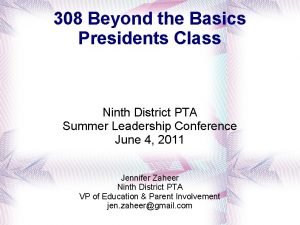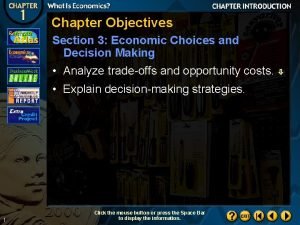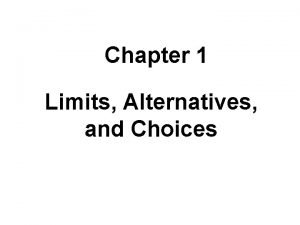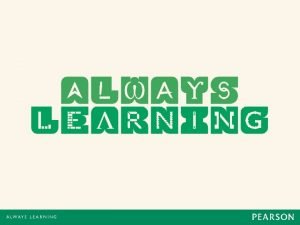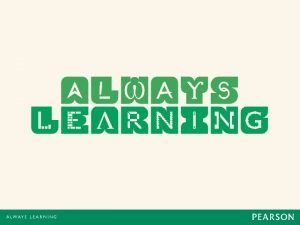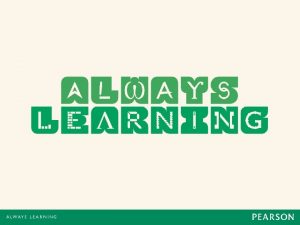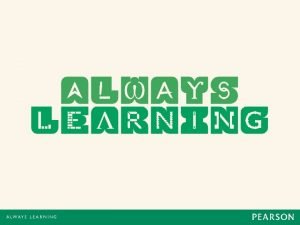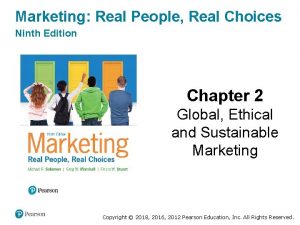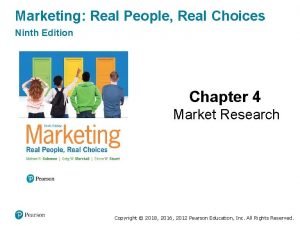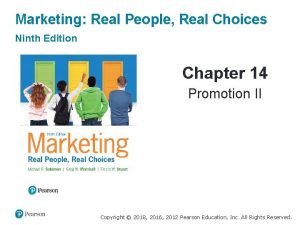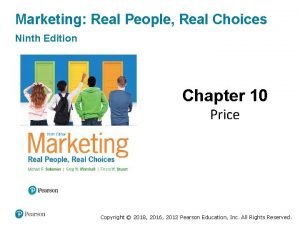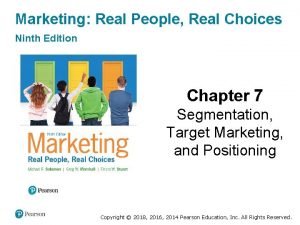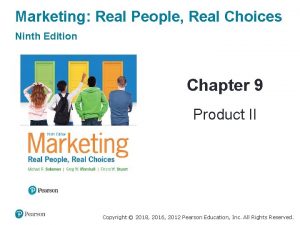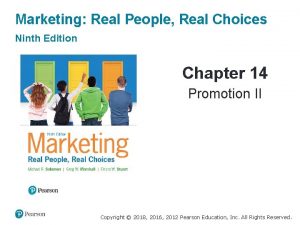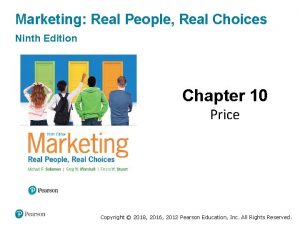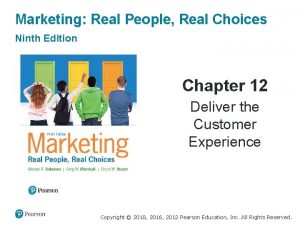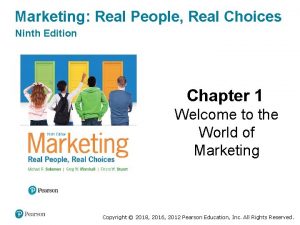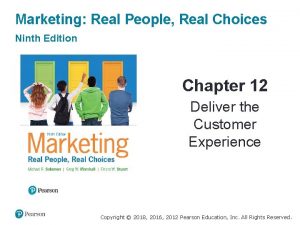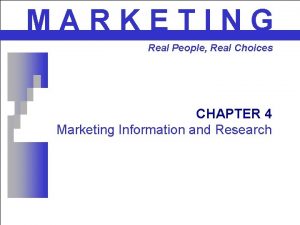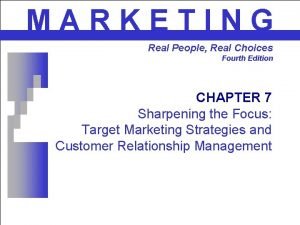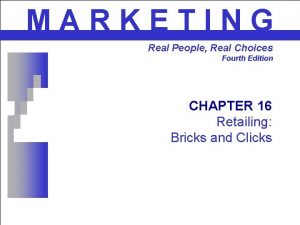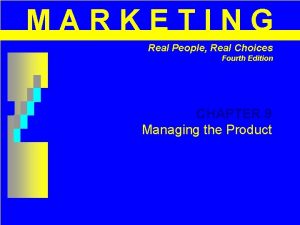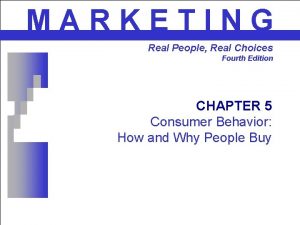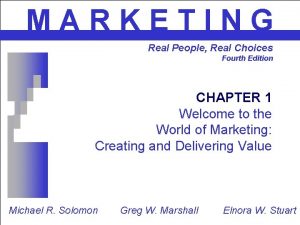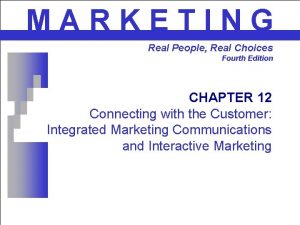Marketing Real People Real Choices Ninth Edition Chapter












































- Slides: 44

Marketing: Real People, Real Choices Ninth Edition Chapter 9 Product II Copyright © 2018, 2016, 2012 Pearson Education, Inc. All Rights Reserved.

Learning Objectives 9. 1 Discuss the different product objectives and strategies a firm may choose. 9. 2 Understand how firms manage products throughout the product life cycle. 9. 3 Explain how branding and packaging strategies contribute to product identity. 9. 4 Discuss how marketers structure organizations for new and existing product management. Copyright © 2018, 2014, 2012 Pearson Education, Inc. All Rights Reserved.

Real People, Real Choices: Quaker Oats • Which option should Becky pursue? § Option 1: Continue the current path with the same brand positioning and target through the master brand approach. § Option 2: Explore a new positioning and target through a consumer deep dive that could halo across all products, yet be customized. Copyright © 2018, 2014, 2012 Pearson Education, Inc. All Rights Reserved.

Product Planning: Develop Product Objectives & Product Strategy • What makes one product succeed while another fails? • Effective product planning is guided by a continuous process of product management. § A systematic and usually team-based approach to coordinating all aspects of a product’s strategy development and execution Copyright © 2018, 2014, 2012 Pearson Education, Inc. All Rights Reserved.

Figure 9. 1 Steps to Manage Products Copyright © 2018, 2014, 2012 Pearson Education, Inc. All Rights Reserved.

Figure 9. 2 Objectives for Single and Multiple Products Copyright © 2018, 2014, 2012 Pearson Education, Inc. All Rights Reserved.

Objectives and Strategies for Individual Products • Objectives and strategies for individual products: § Successful introduction of new products § Taking regional product nationwide § Breathing new life into mature products while maintaining a distinct brand personality Copyright © 2018, 2014, 2012 Pearson Education, Inc. All Rights Reserved.

Objectives and Strategies for Multiple Products • A product line is the firm’s total product offering designed to satisfy a single need or desire of target customers. § Product line length is determined by the number of stock keeping units (SKUs). • Product line strategies: § Full-line vs. limited-line strategies § Upward, downward, or two-way line stretch § Filling out or contracting a product line • Cannibalization is a risk Copyright © 2018, 2014, 2012 Pearson Education, Inc. All Rights Reserved.

Product Mix Strategies • A product mix is the total set of products a firm offers for sale. • Product mix strategies § Width of product mix must be considered. § Product lines in mix usually have some things in common. Copyright © 2018, 2014, 2012 Pearson Education, Inc. All Rights Reserved.

Product Mix and Product Line Decisions (1 of 2) Product Lines Mercedes-Benz Cars Mercedes-AMG cars Smart Cars Mercedes-Benz Vans A-Class C 63 Smart For. Two Sprinter Worker B-Class CLS 63 Smart For. Two Cabrio Sprinter Cargo Van C-Class GLE 450 Smart For. Four Sprinter Crew Van CLA SL Convertible Smart For. Two Electric Drive Sprinter Passenger Van CLS GT Metro Passenger Van G-Class Metro Cargo Van E-Class Marco Polo Camper Van GLA R-Class S-Class V-Class 10 © Mc. Graw-Hill Education

Quality as a Product Objective: TQM and Beyond • Product quality is often a key objective. • A philosophy of total quality management (TQM) can help companies achieve quality objectives. Copyright © 2018, 2014, 2012 Pearson Education, Inc. All Rights Reserved.

Quality Guidelines • ISO 9000 § Standards for quality management • ISO 14000 § Standards for environmental management • Six Sigma methodology § Process allows no more than 3. 4 defects per million units (getting it right 99. 997% of the time) Copyright © 2018, 2014, 2012 Pearson Education, Inc. All Rights Reserved.

Figure 9. 3 Product Quality Copyright © 2016, 2014, 2012 Pearson Education, Inc. All Rights Reserved

Marketing throughout the Product Life Cycle • Many products have long lives, while others are fads that are “here today, and gone tomorrow. ” • The product life cycle (PLC) is a useful way to explain how market response and marketing activities change over the life of a product. Copyright © 2018, 2014, 2012 Pearson Education, Inc. All Rights Reserved.

Figure 9. 4 The Product Life Cycle Copyright © 2016, 2014, 2012 Pearson Education, Inc. All Rights Reserved

Introduction Phase of PLC • New products that are offshoots of well-known brands have an advantage. • Many products never make it out of the introduction phase due to low awareness. § § As many as 95% of new products ultimately fail! Effective advertising and promotion is essential. Copyright © 2018, 2014, 2012 Pearson Education, Inc. All Rights Reserved.

Growth, Maturity, and Decline Stages of the PLC • Growth stage of the PLC § The product is accepted and sales rapidly increase. • Growth stage of the PLC § Typically longest phase § Sales peak while profit margins narrow. • Decline stage of the PLC § Sales decrease as customer needs change. Copyright © 2018, 2014, 2012 Pearson Education, Inc. All Rights Reserved.

Figure 9. 5 Marketing Mix Strategies throughout the Product Life Cycle Copyright © 2018, 2014, 2012 Pearson Education, Inc. All Rights Reserved.

Product Life Cycles Phases • PLC framework a useful tool to think about how marketing tactics change over time. § Sometimes hard to know when a product passes from one stage to the next. § Some companies are now using social media to bring products “back from the dead. ” Up to 95% of new products ultimately fail. What are some implications of this statistic for marketers? Copyright © 2018, 2014, 2012 Pearson Education, Inc. All Rights Reserved.

Diffusion Process and PLC Curve Copyright © 2018, 2014, 2012 Pearson Education, Inc. All Rights Reserved.

What Makes a Brand? • Logos and symbols • Characters • URLs • • Slogans www. e. Bay. com • Brand name • Branding • Jingles/ • Sounds Copyright © 2018, 2014, 2012 Pearson Education, Inc. All Rights Reserved. © Mc. Graw-Hill Education

What’s in a Name (or a Symbol)? • A “good” brand name: § maintains relationships with customers. § positions a product by: (1) portraying an image or (2) describing how the product works. § is easy to say, spell, read, and remember. § fits the target market, product benefits, customer’s culture, and legal requirements. Copyright © 2018, 2014, 2012 Pearson Education, Inc. All Rights Reserved.

Trademarks • Trademark is the legal term for a brand name, brand mark, or trade character. § Trademarks legally registered by a government obtain protection for exclusive use in that country. § ® is the trademark symbol used in the U. S. § Common-law protection Visit the U. S. Patent and Trademark Office (USPTO) Copyright © 2018, 2014, 2012 Pearson Education, Inc. All Rights Reserved.

Why Brands Matter • A brand is a lot more than just the product it represents. § Strong brands build emotional connections with customers. • Brand equity refers to a brand’s value to its organization over and above the value of the generic version of the product. § Brand equity provides competitive advantage. § Brand equity results in brand loyal consumers and attachment. Copyright © 2018, 2014, 2012 Pearson Education, Inc. All Rights Reserved.

Brand Equity for the Owner Country Sector Brand Value (in $ Billions) Apple United States Technology $170. 3 2 Google United States Technology $120. 3 3 3 Coca-Cola United States Beverages $78. 4 4 5 Microsoft United States Technology $67. 7 5 4 IBM United States Business Services $65. 1 6 10 Toyota Japan Automotive $49. 0 7 8 Samsung South Korea Technology $45. 3 8 6 GE United States Diversified $42. 3 9 7 Mc. Donald's United States Restaurants $39. 8 10 n. a. Amazon United States Retail $37. 9 2015 Rank 2013 Rank 1 1 2 Brand Copyright © 2018, 2014, 2012 Pearson Education, Inc. All Rights Reserved. © Mc. Graw-Hill Education Source: From Interbrand. com, http: //interbrand. com/best-brands/best-global-brands/2015/ranking/#? list. Format=ls.

Brand Meaning • Strong brands forge lasting bonds with customers based on brand meaning. § Brand meaning encompasses the beliefs and associations a consumer has about the brand. • Today, brand meaning builds virally as people spread its story online. § Through brand storytelling, marketers seek to engage consumers with compelling stories about brands. Copyright © 2018, 2014, 2012 Pearson Education, Inc. All Rights Reserved.

Characteristics of World Class Brands 1. The brand excels at delivering the benefits customers desire. 2. The brand stays relevant. 3. The pricing strategy is based on consumer’s perceptions of value. 4. The brand is properly positioned. 5. The brand is consistent. 6. The brand portfolio and hierarchy make sense. 7. The brand coordinates a full repertoire of marketing activities to build equity. 8. The brand’s managers understand what the brand means to consumers. 9. The brand is given proper support. 10. The company monitors sources of equity. Copyright © 2018, 2014, 2012 Pearson Education, Inc. All Rights Reserved.

Brand Extensions and Sub-Branding • Products with strong brand equity provide exciting opportunities for marketers. § Brand extensions arise from a firm leveraging brand equity to sell new products using the same brand name. § Sub-branding occurs when a firm creates a secondary brand to help differentiate a product line (e. g. , Virgin Mobile, Virgin Atlantic, Virgin Galactic). Copyright © 2018, 2014, 2012 Pearson Education, Inc. All Rights Reserved.

Figure 9. 6 Branding Strategies Copyright © 2016, 2014, 2012 Pearson Education, Inc. All Rights Reserved

Individual vs. Family Brands • Family brand strategy is when product items share a common brand name. • Family brands such as Campbell’s provides an umbrella under which multiple products can be effectively marketed. Copyright © 2018, 2014, 2012 Pearson Education, Inc. All Rights Reserved.

National and Store Brands • National brands are those produced and marketed by a manufacturer. • Store (or private label) brands are those which are offered by a retail store or chain under an exclusive trade name. § Costco: Kirkland’s § Wal-Mart: Sam’s Choice § Others? Copyright © 2018, 2014, 2012 Pearson Education, Inc. All Rights Reserved.

Generic Brands • Generic brands is a strategy in which products are not branded and are sold at lowest price possible. § Typically packaged in white with black letters that only names the product itself (“Green Beans”) Copyright © 2018, 2014, 2012 Pearson Education, Inc. All Rights Reserved.

Licensing • Licensing is when one firm sells to another firm the right to use a brand name for a specific purpose for a specific period of time. Copyright © 2018, 2014, 2012 Pearson Education, Inc. All Rights Reserved.

Cobranding • Cobranding: Two brands agree to work together to market a new product • Ingredient branding: Branded materials become “component parts” of other branded products. Copyright © 2018, 2014, 2012 Pearson Education, Inc. All Rights Reserved.

Packages and Labels: Branding’s Little Helpers • A package is the covering or container for a product. • Serves both functional and communication purposes § Branding § UPC codes Copyright © 2018, 2014, 2012 Pearson Education, Inc. All Rights Reserved.

Figure 9. 7 Functions of Packaging Copyright © 2018, 2014, 2012 Pearson Education, Inc. All Rights Reserved.

Design Effective Packaging (1 of 2) • Effective packaging design entails many decisions § How are other products in category packaged and displayed? § Copycat packaging Copyright © 2018, 2014, 2012 Pearson Education, Inc. All Rights Reserved.

Design Effective Packaging (2 of 2) • Effective packaging also considers: § § Choice of packaging material and the image it projects Environmental impact of packaging Shape and color influences on image Graphic information to be portrayed Copyright © 2018, 2014, 2012 Pearson Education, Inc. All Rights Reserved.

Labeling Regulations • Fair Packaging and Labeling Act (1966): § Federal legislation aimed at making labels more helpful to consumers by providing useful information. • Nutrition Labeling and Education Act (1990) § Law requires food labels to state how much fat, saturated fat, cholesterol, calories, carbohydrates, protein, and vitamins are in each product serving. Copyright © 2018, 2014, 2012 Pearson Education, Inc. All Rights Reserved.

Branding and Packaging • Branding and packaging decisions play an essential role in shaping how consumers view a product. § While there are many types of decisions to be made, each should conform with the overall product strategy and needs of target markets. Is it fair for retailers like Walgreens and Wal-Mart to use copycat packaging on store branded products? Copyright © 2018, 2014, 2012 Pearson Education, Inc. All Rights Reserved.

Organize for Effective Product Management • Product strategies are only as effective as the managers that create them and carry them out. • In larger firms, various types of managers may be involved in the process: § Brand managers § Product category managers § Market managers Copyright © 2018, 2014, 2012 Pearson Education, Inc. All Rights Reserved.

Figure 9. 8 Types of Product Management Copyright © 2018, 2014, 2012 Pearson Education, Inc. All Rights Reserved.

Organize for New Product Development • Launching new products is so important; many firms pay special attention to the introductory phase of the PLC • Within larger companies, cross-functional teams are formed by enlisting specialists from different areas. § Skunk works: venture teams located away from traditional company offices Copyright © 2018, 2014, 2012 Pearson Education, Inc. All Rights Reserved.

Copyright © 2018, 2014, 2012 Pearson Education, Inc. All Rights Reserved.
 Marketing real people real choices 11th edition
Marketing real people real choices 11th edition Ch 9 ream people real choice case study
Ch 9 ream people real choice case study Marketing real people real choices
Marketing real people real choices Levels of analysis psychology
Levels of analysis psychology Macroeconomics mankiw 9th edition
Macroeconomics mankiw 9th edition Anatomy and physiology edition 9
Anatomy and physiology edition 9 Psychology ninth edition david g myers
Psychology ninth edition david g myers Social psychology ninth edition
Social psychology ninth edition Biology ninth edition
Biology ninth edition Child development ninth edition
Child development ninth edition Child development 9th edition
Child development 9th edition Abnormal psychology ronald j comer 9th edition
Abnormal psychology ronald j comer 9th edition Psychology ninth edition in modules
Psychology ninth edition in modules Psychology ninth edition david g myers
Psychology ninth edition david g myers Biology ninth edition
Biology ninth edition Campbell ninth edition
Campbell ninth edition Marketing real people real decisions
Marketing real people real decisions Marketing real people real decisions
Marketing real people real decisions Examples of reactive language
Examples of reactive language Proactive vs reactive scenarios
Proactive vs reactive scenarios Proactive people make choices based on
Proactive people make choices based on Proactive vs reactive language
Proactive vs reactive language Non national loyalties
Non national loyalties How do nationalist loyalties shape people's choices
How do nationalist loyalties shape people's choices Marketing real people
Marketing real people 6th and 9th commandments
6th and 9th commandments The sixth and ninth commandments
The sixth and ninth commandments Phos root word
Phos root word What's ramadan
What's ramadan William blount 9th grade academy
William blount 9th grade academy Lower ninth ward
Lower ninth ward Farineux
Farineux Ninth district pta
Ninth district pta Mis chapter 6
Mis chapter 6 Using mis 10th edition
Using mis 10th edition The health skill that involves taking the time
The health skill that involves taking the time Lesson 2 our economic choices
Lesson 2 our economic choices When making smart food choices what question
When making smart food choices what question Explain how job choices affect income.
Explain how job choices affect income. Chapter 1 section 3 economic choices and decision making
Chapter 1 section 3 economic choices and decision making Economizing problem definition
Economizing problem definition Marketing management (arab world edition)
Marketing management (arab world edition) Marketing management (arab world edition) philip kotler
Marketing management (arab world edition) philip kotler Marketing management (arab world edition) philip kotler
Marketing management (arab world edition) philip kotler Principles of marketing arab world edition
Principles of marketing arab world edition

